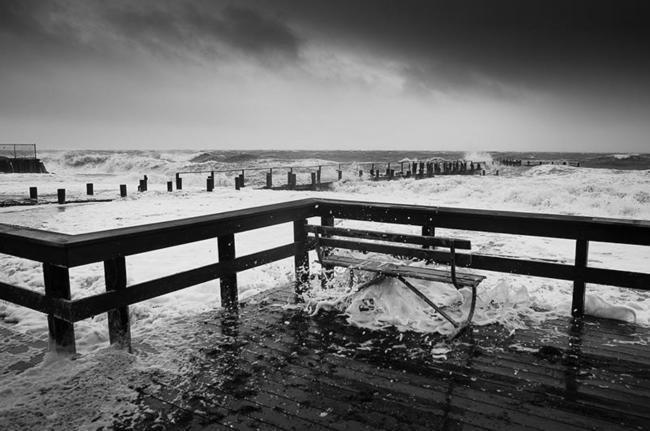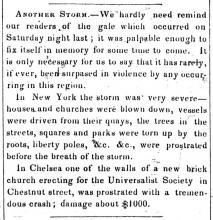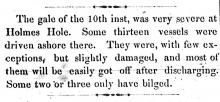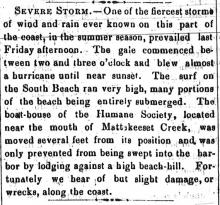The back road between Edgartown and Vineyard Haven seemed to have weathered the storm pretty well, bordered by sturdy scrub oak. However, as the road nears Vineyard Haven, the taller trees in the vicinity took a severe beating and consequently, so did the power lines.
In Vineyard Haven, Beach road was inundated and was still impassable in the middle of the afternoon. Merchants with businesses on the road, who appeared to start a day’s work, soon found that they were marooned throughout the morning and part of the afternoon. Beach street was also flooded. Stray boats and planks from the Tilton Lumber Company, accompanied by odds and ends of driftwood floated along the street and into the yard of the 1785 House and on the ferry wharf, which was hidden almost to the Railway Express Building.
The Curve of beach from the ferry landing to the breakwater was a veritable graveyard of boats when the water receded, boats of all sized, although quite a few which were tied up in the harbor remained tethered to their moorings throughout the storm. On the first long pier, a stub-by-looking motor cruiser was left perched precariously on top of the piles. Nearby, another cruiser was left submerged except for the cabin top, and out of the window what appeared to a window shade fluttered in the strong afternoon breeze. The beach boats, though did not appear to be damaged to heavily.
A drive around West Chop in the afternoon showed that that community suffered most heavily from tree casualties, several large ones having fallen across the road. Two piers, the Greenoughs being one of them, were washed out, and a number of small boats were freed from their moorings and washed about, but the damage in that quarter had not been estimated by that time. There was evidence that the lowest point of the road that circumnavigates the Chop was washed over.
Everywhere in Vineyard Haven, people were out in the early afternoon, while wind was still high. The ones who had property had already set to work repairing it, cleaning yards and removing fallen tree limbs that could be removed. In one yard, two elderly women and one elderly man were putting a ladder against a tree preparatory to taking down a hanging limb big enough to make a sizable tree itself. They were undaunted. The people who weren’t concerned about property were out to see as much as they could. Cameras were almost as numerous as the people, and it was felt that surely this Vineyard storm was goung to be thoroughly recorded on film or history.
Lobersterville suffered the greatest damage, despite the serene appearance of the place through binoculars. The new house, completed a week before by Richard D. Morris of Oak Bluffs, completely disappeared. The home of Elizabeth Howe, in East Pasture, was lifted off the foundation and all windows were blown in. The Albert Saunders cottage had its front wrecked, and nearly all summer inhabitants were driven from the houses by rising water, many of them leaving at the height of the storm and experiencing the greatest difficulty because the water had soaked down the ignition system of cars. The Red Cross helped many of them to get their cars out of danger, and found shelter for those who had no place to go.
At Stonewall Beach there was much damage, with boats and bath houses carried away and four feet of water standing in several of the houses. All but one boat in Menemsha Pond dragged or parted from moorings and went ashore, chiefly in the cranberry bogs.










Comments